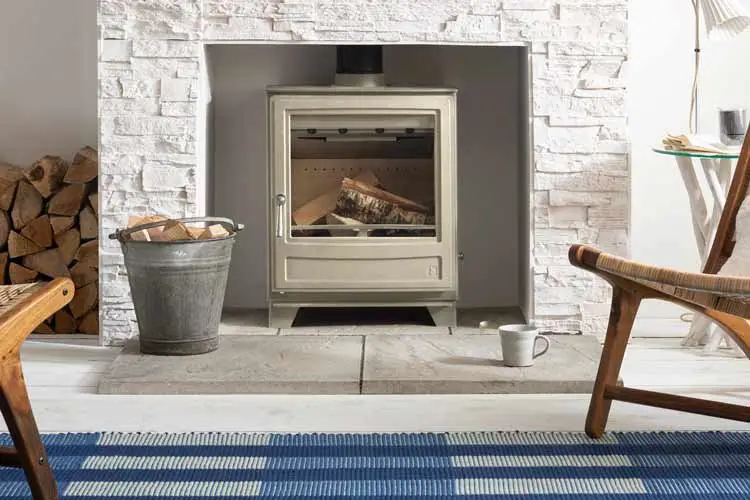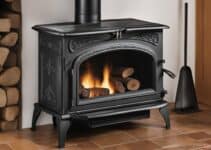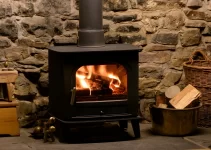A cream log burner can add a touch of levity and freshness to a contemporary home. However, many wood stove lovers looking to bring a fresh look into their living room worry that a brand new cream exterior could eventually look sooty, yellow, or discoloured.
But, do cream log burners discolour? If your cream or white log burner is of good quality and is properly cared for, it should be possible to maintain a clean looking finish even after years of use. That being said, a light cream exterior will undoubtedly show any sooty marks, grime or cracks more clearly than a darker cast iron surface.
The surface of your stove, whether it is painted or enamel, may also determine how easy your stove exterior is to clean and keep from discolouring.
Enamel stoves are commonly seen as being easier to keep clean day-to-day, though they can be vulnerable to chips and accidental damage.
What’s more, some enamel can crack with excessive heat or improper stove use. These cracks are likely to show up more clearly on a cream or white stove.
That being said, good quality cream enamel shouldn’t crack or discolour with age or use, and many proud owners of cream enamel wood stoves claim they’ve had their stove for years without significant discolouration.

Do white log burners get dirty?
Of course, white wood burners are no more or less liable to get dirty than any other colour of wood stove. Nevertheless, sooty marks, dust, and general grime are always going to be more visible on a lighter surface.
Stoves with enamel exteriors are generally seen as being easier to keep clean on a day-to-day basis, which can be good news if you’re set on a cream wood burning stove.
Any blemishes showing up on a white enamel surface can usually be dispatched with a damp cloth.
A simple matt or paint finish that maintains the rough surface of the core metal can trap dust and smoke more easily.
Matt surfaces are also more difficult to clean regularly when compared to the smooth, wipeable surface of enamel.
On darker stoves this may be less noticeable, though even owners of dark matt stoves sometimes complain that they are hard to keep free of dust and grime.
On the other hand, painted stoves can often be given a new lease of life relatively easily by applying a new paint layer. Of course, this is true of coloured log burners.

If you find that discolouration or wear-and-tear marks have built up over time on the painted surface of your white stove, a fresh coat of heat-resistant paint can make your stove look practically brand new.
Such DIY makeovers are less likely to be possible with enamel stoves.
Finally, coloured log burners are more liable to show chips and impact damage than their darker counterparts. This can give them a more worn appearance over time.
Accidental knocks with metal pokers and other fireplace equipment, or clumsy installation, can chip enamel relatively easily. Such blemishes will show up more readily on a cream wood burning stove.
How to prevent log burner from discolouring
The most common form of discolouration experienced by wood stove owners is usually on the glass interior of the stove door, rather than on the exterior surface.
Sooty deposits often form on the glass due to the by-products of combustion.
These deposits can be reduced significantly by ensuring when you light your log burner you burn only properly seasoned, kiln dried wood.
In terms of exterior discolouration or blemishes, these could conceivably be caused by over firing. Each wood stove is designed to function within an optimum temperature range.
Fires outside of this range, caused by excessive fuel or oxygen, can warp or damage the metal, which in turn could cause cracks in the exterior surface of your stove.
To avoid over firing, use a stove thermometer to monitor the temperature of your stove, keep fires within the temperature limits outlined by your stove manufacturer, and avoid over fuelling with wood.
Discolouration on the inside of your stove can usually be dealt with either using store bought stove cleaning equipment or via a range of popular home remedies.
Scrubbing the glass door with newspaper and old wood ashes is a commonly suggested solution. Others may wish to try bicarbonate of soda.
The exterior of your stove will usually, in the case of enamel surfaces, be cleanable with a damp cloth or soft brushed hoover.
As mentioned, owners of matt surface stoves sometimes report that they appear to attract and hold onto dirt more readily than their enamel cousins.
Stove cleaners and stove polishing products are also available for discoloured matt stoves, though potentially proving more costly and complicated than a simple wipe down with a damp cloth.




